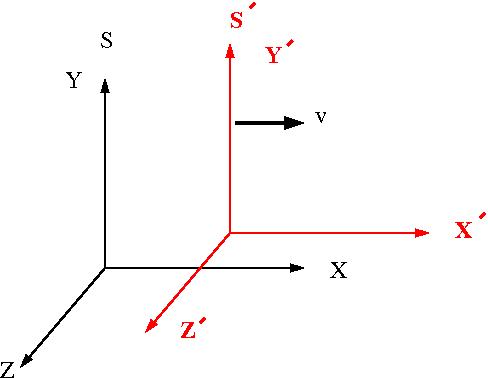Difference between revisions of "Forest Relativity Notes"
Jump to navigation
Jump to search
| Line 43: | Line 43: | ||
:<math>\left ( \begin{matrix} ct^{\prime} \\ x^{\prime} \\ y^{\prime} \\ z^{\prime} \end{matrix} \right )= \left [ \begin{matrix} \sec(\alpha) & -\tan(\alpha) & 0 & 0 \\ -\tan(\alpha) & \sec(\alpha) &0 &0 \\ 0 &0 &1 &0 \\ 0 &0 &0 &1\end{matrix} \right ] \left ( \begin{matrix} ct \\ x \\ y \\ z \end{matrix} \right )</math> | :<math>\left ( \begin{matrix} ct^{\prime} \\ x^{\prime} \\ y^{\prime} \\ z^{\prime} \end{matrix} \right )= \left [ \begin{matrix} \sec(\alpha) & -\tan(\alpha) & 0 & 0 \\ -\tan(\alpha) & \sec(\alpha) &0 &0 \\ 0 &0 &1 &0 \\ 0 &0 &0 &1\end{matrix} \right ] \left ( \begin{matrix} ct \\ x \\ y \\ z \end{matrix} \right )</math> | ||
| + | |||
| + | ; Or the reverse transformation | ||
| + | |||
| + | :<math>\left ( \begin{matrix} ct \\ x \\ y \\ z \end{matrix}\right )= \left [ \begin{matrix} \sec(\alpha) & -\tan(\alpha) & 0 & 0 \\ -\tan(\alpha) & \sec(\alpha) &0 &0 \\ 0 &0 &1 &0 \\ 0 &0 &0 &1\end{matrix} \right ] \left ( \begin{matrix} ct^{\prime} \\ x^{\prime} \\ y^{\prime} \\ z^{\prime} \end{matrix} \right )</math> | ||
=Proper Time and Length= | =Proper Time and Length= | ||
Revision as of 17:03, 30 October 2007
Lorentz Transformations
The picture below represents the relative orientation of two different coordinate systems . is at rest (Lab Frame) and is moving at a velocity v to the right with respect to frame .
The relationship between the coordinate of an object in frame to the same object described using the coordinates in frame is geven by the Lorentz transformation:
where
- example
- Or in matrix form the tranformation looks like
- Note
- Einstein's summation convention drops the symbols and assumes it to exist whenever there is a repeated subscript and uperscript
- ie;
- in the example above the symbol is repeated thereby indicating a summation over .
Trig Method
Another way to represent the lorentz transformation is by using the substitution
- The Matrix form pf the tranformation looks like
- Or the reverse transformation
Proper Time and Length
Proper Time
- Proper Time
- The time measured in the rest frame of the clock. The time interval is measured at the same x,y,z coordinates because the clock chose is in a frame which is not moving (rest frame).
The time given in any frame (t) =
- Note
- since you expect the Proper time interval to be the smallest
Proper Length
- Proper Length
- An object length in the object's rest frame.
